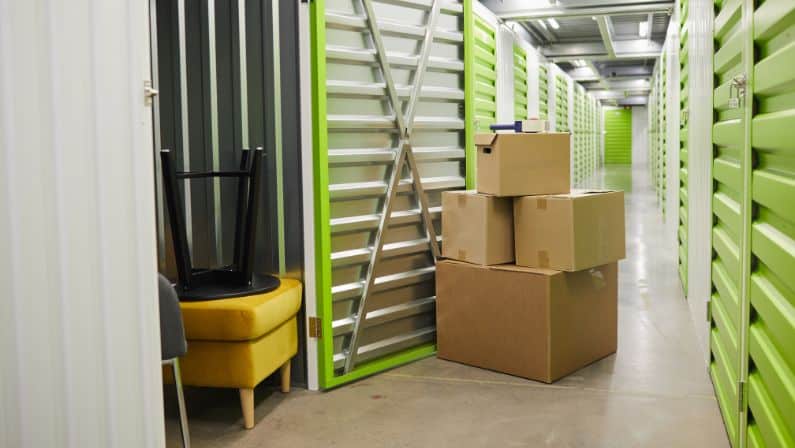How Do You Store Furniture in a Storage Unit?
Storing furniture in a storage unit can be a great way to free up space in your home or office. But if you’ve never done it before, it can be a bit daunting.
This article will give you some tips and tricks in order to make sure that your furniture is stored safely and securely in your storage unit.
Planning to Store Your Furniture?
While furniture pieces can be individually wrapped and stored in boxes, it may make more sense to store them as a group.
However, there are some more ways to do it, such as:
Determine the size you’ll need
Most furniture pieces come in huge sizes. It’s important to measure the dimensions of each piece and determine how much space you’ll need in your storage unit.
Estimate your move-in cost
Depending on your location, move-in costs may differ. In some cases, the first month’s rent may be free. However, there may be other costs associated with moving your furniture into storage, such as a damage deposit or admin fee.
Ask about discounts, specials, and bundles
One of the questions you should ask the storage facility manager is whether they offer any discounts, specials, or bundles. For example, some storage facilities offer a free month of storage when you sign a long-term contract.
Check for extra charges like pest control and insurance
Make sure to ask about any extra charges that may be associated with storing your furniture. These can include pest control fees and insurance.
Rent for month-to-month or longer to save money
In general, the longer you rent, the cheaper it will be. So if you’re planning on storing your furniture for a long period of time, it’s best to opt for a month-to-month or longer rental agreement.
Security and access requirements
Ask the storage facility manager about their security and access requirements. This is important, especially if you’re storing valuable or sensitive items.

How to store furniture in a storage unit
When storing furniture in a storage unit, you need to keep in mind certain things, such as:
Pick the most secure storage facility
Not all storage facilities are created equal. Some are more secure than others. When storing your furniture, it’s important to pick a storage facility that has high security features, such as CCTV cameras, gate codes, and on-site security guards.
Examine each piece of furniture before placing it in storage
Before placing your furniture in storage, inspect it for any damage. If you find any damage, make sure to repair it before storing.
Clean and dry all furniture before storage
You should clean and dry all furniture before placing it in storage. This will help prevent the growth of mold and mildew.
Wrap your furniture in bubble wrap or packing paper
To prevent scratches and other damage, wrap all furniture in plastic or packing paper. If you’re using packing paper, make sure to use ones that are acid-free and lint-free.
Cover each piece with a heavy-duty tarp or furniture cover
In addition to wrapping your furniture in plastic or packing paper, you can also use furniture tarps or blankets. This will help protect your furniture from bumps and scratches.
Disassemble your furniture if possible
If possible, disassemble your furniture before storing. This will help save space in your storage unit.
Avoid leaving food behind
Avoid leaving food behind
When storing your furniture, make sure to remove all food from each piece. This will help prevent the growth of mold and mildew.
Don’t Directly Place Them on the Floor
You should avoid placing your furniture directly on the floor. Instead, use pallets or furniture blankets to create a buffer between your furniture and the floor. This will help prevent moisture and pests from damaging your furniture.
Prevent damage by storing small pieces together
Small pieces of furniture, such as chairs and tables, should be stored together. This will help prevent them from getting lost or damaged.
Store heavy furniture on the bottom
To prevent your furniture from tipping over, store the heavy pieces on the bottom and the lighter pieces on top.

Storage Tips to Protect Your Furniture
To keep your furniture’s condition at its best, here are some storage tips you can do:
- Keep it clean: Before putting your furniture into storage, make sure to clean it. This will help remove any dirt, dust, or stains that may damage your furniture.
- Use a storage cover: A storage cover can help protect your furniture from dust, dirt, and moisture.
- Remove the legs before storing: If possible, remove the legs of your furniture before storing. This will help prevent them from getting damaged or lost.
- Create a pad of paper and cardboard: To prevent your furniture from getting scratched or dented, use padding when storing them. Aside from pads of paper and cardboard, you can use blankets, quilts, or towels as padding.
- Wrap Valuable Pieces with Cloth or Bubble Wrap: Related to the tip above, you should wrap your valuable furniture with cloth or bubble wrap. This will help prevent them from getting damaged while in storage.
- Keep Your Furniture Upright and Cushioned: To prevent your furniture from getting damaged, keep them upright and cushioned. You can use furniture pads or blankets to cushion your furniture.
- Look into climate control: When storing your furniture, make sure to avoid extremely hot or cold temperatures. This can damage the material of your furniture.

Benefits of storing furniture in storage units
There are several benefits in storing furniture in storage units, such as:
Protection from the elements
When you store your furniture in a storage unit, you can protect them from the elements, such as wind, rain, snow, and sun.
Keeps furniture in good condition
Storing your furniture in a storage unit can help keep them in good condition. This is because storage units are typically clean and dry, which prevents the growth of mold and mildew.
Easy to access in a storage unit
When you need to access your furniture, you can easily do so in a storage unit. This is because storage units are typically large and have easy-to-access doors.
Keeps your home or office clean and well-organized
When you store your furniture in a storage unit, it can help keep your home or office clean and well-organized. This is because you will have more space to move around without having to worry about your furniture.
Saves time and energy on maintenance
When you store your furniture in a storage unit, you won’t have to spend time and energy on maintaining them. This is because storage units are typically clean and dry, which prevents the growth of mold and mildew.
Safer than keeping it at home or office
Lastly, storing your furniture in a storage unit is safer than keeping them at your home or office. This is because storage units have security features, such as security cameras and alarms, which help deter burglars and thieves.
How long can you keep furniture stored?
Furniture pieces should be stored for no longer than 3-5 years. This is to prevent the material from degrading and becoming damaged.
Safely Store Your Furniture the Right Way
Storing furniture pieces shouldn’t be complicated. All you need to do is to follow the tips above and you’ll be able to store your furniture pieces safely. Just make sure to choose a storage unit that is clean, dry, and has easy access.
Do not forget to label your furniture pieces so you can easily find them when you need to. Lastly, check on your furniture from time to time to make sure its condition is at its best.
We at Iron Storage provide storage units that are clean, dry and have easy access. We also have a wide variety of storage unit sizes to choose from. Contact us today and we’ll help you find the perfect storage unit for your needs.
Author
-
Faraz Hemani has been in the self storage industry for several years. He is on the executive team at Iron Storage, and has helped grow the company through acquisitions, operations and strategic initiatives.
View all posts







